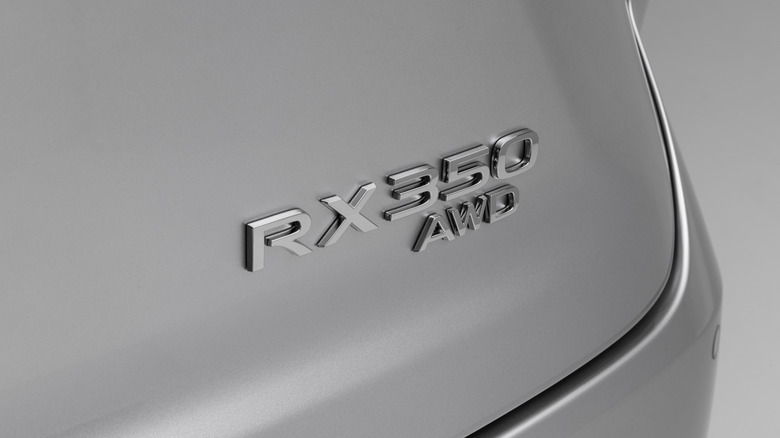What Does 'RX' Mean On The Lexus RX 350? (And Just How Big Is It?)
The Lexus RX, introduced in 1998, is one of the most significant models in the brand's range. It's often considered the world's first true luxury SUV, and remains one of the most popular luxury vehicle options for people seeking a suitably comfortable car with high quality materials and abundant technology.
The crossover originally launched as the Lexus RX 300, but went on to adorn other monikers, such as the RX 350 in the following decades. If you've been shopping around for a luxury crossover SUV lately, there's a good chance you've seen the RX 350 designation on the rears of some new or used Lexus options.
What does RX actually mean in the context of Lexus? RX is an acronym for Radiant Crossover. Lexus says the Radiant part of the RX's name embodies "the bright new future" it imagined for the RX SUV when it debuted. The crossover part, meanwhile, points to the RX 350 being built on a car platform, and accordingly combining features of both SUVs and regular cars.
The 2025 Lexus RX, for example, is built upon the Toyota GA-K unibody platform shared with cars such as the current generation Toyota Camry and Lexus ES. Other popular models such as the Toyota RAV4 and Highlander also utilize the GA-K platform, but they all differ in their dimensions.
Is the Lexus RX 350 bigger than the Toyota RAV4?
Overall, the Lexus RX 350 is bigger than the Toyota RAV4. It's 11.6 inches longer for one thing, measuring 192.5 inches compared with 180.9 inches for the 2025 Toyota RAV4. It's also wider and taller at 75.6 and 67.3 inches, respectively, as opposed to 73.0 inches of width and 67.0 inches of height for the RAV4. Furthermore, the RX 350 boasts a more spacious interior on the whole, offering more shoulder and hip room than the RAV4.
However, both SUVs share almost identical dimensions in regard to headroom and legroom, with the RX 350 having 39.5 inches of headroom without the sunroof, and 38.6 inches if the sunroof is equipped, in the first and second rows, while the RAV4 provides 39.5 inches both front and back in models without the sunroof.
Both also provide quite a significant amount of legroom, with the RX 350 measuring 41.1 inches up front and 37.4 inches in the second row, while with the RAV4 you get 41.0 inches in front and 37.8 inches of legroom out back.
Despite being the bigger car in terms of exterior dimensions, the RX 350 loses out to the RAV4 when it comes to cargo space. With all seats upright, there's 29.6 cubic feet, which increases to 46.2 cubic feet when the second row seats are folded down. By comparison, the standard cargo area in the Toyota RAV4 is 37.6 cubic feet in five-seat mode. Drop the rear seats, and you have a pretty huge 69.8 cubic feet of cargo room.
RX 350 vs Toyota Highlander
The Lexus RX 350 and current Toyota Highlander both have a 112.2-inch wheelbase, but the Highlander is longer, wider, and taller than the RX 350, with its length coming in at 194.9 inches, while the width and height measure 76.0 and 68.1 inches, respectively. Although their exterior dimensions are pretty close, the difference between the two in terms of their interior space is pretty substantial. The current generation Toyota Highlander is designed to accommodate between seven and eight passengers, while the RX 350 is restricted to five seats.
That, naturally, means the Highlander interior is bigger overall. Toyota's measurements show the Highlander also trumps the RX 350 in terms of both front and second row headroom and legroom space. Those in the front can enjoy up to 41.2 inches of headroom and 42.0 inches of legroom, while headroom and legroom in the Highlander's second row stand at 39.4 and 38.7 inches.
As you'd expect, space in the third row is a little compromised, with occupants having to make do with 36.1 inches of headroom and 28.0 inches of legroom. The Highlander retains a decent 16.0 cubic feet of space with all seats in place, and that can further expand to a maximum of 84.3 cubic feet when you fold down the third and second row seats.


